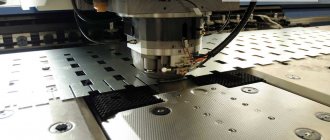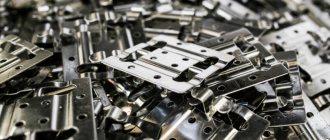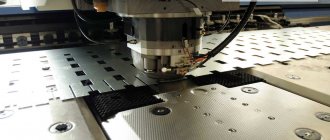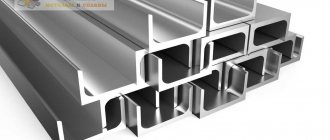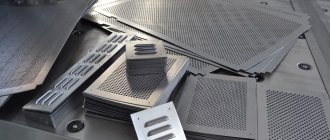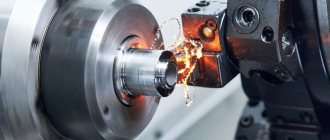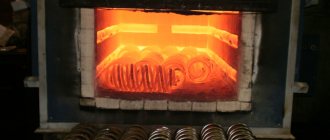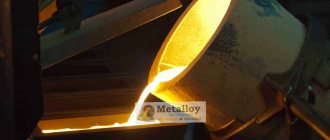Sheet metal stamping - general information about the operation
Stamping of parts from sheet metal - this process refers to the production of finished products, various parts and semi-finished products from metals by deforming the raw materials under pressure.
Our distant ancestors knew similar technology, who, through elementary stamping, made weapons, all kinds of jewelry and household items.
Since the 1850s, the described type of processing began to be modernized and technically improved, which made it possible to mass-produce a variety of products for mass demand by stamping. Moreover, the finished stamped products were distinguished by quite high quality and excellent performance characteristics.
With the advent of the 20th century, sheet stamping of metal products reached a completely new production and technical level. Thanks to it, the automobile production sector began to develop (vehicle bodies and many other parts were made from stamped material). In the 1930s, stamping was adopted by shipbuilding and aircraft manufacturing enterprises, and after a couple of decades it became indispensable for the needs of rocketry.
Stamped metal structures are characterized by a number of special properties, which, in principle, determined the popularity of the technology in question. Its advantages include the following features:
- mechanization and automation of production processes, which are achieved through the introduction of powerful rotary conveyor lines of equipment;
- production of any geometric parameters and shapes of ready-to-use products and various semi-finished products;
- production of high-precision dimensional parts that interchange each other without the need for additional processing using cutting tools and equipment.
In addition, hot and cold stamping guarantees the production of relatively “modest” metal products with rational shapes and high strength parameters. Sheet stamping operations make it possible to produce both massive blanks for shipbuilding, machine and automotive enterprises, and thin-walled, literally filigree parts (for example, thin hands for watches).
It is also impossible not to note separately the high productivity of the sheet stamping operation and the possibility of obtaining, when used in conjunction with welding operations, all-in-one type assemblies of any size, which production industries such as shipbuilding and carriage building cannot do without.
Manufacturing of products from non-ferrous metals
Metal products make up a significant part of industrial products. They are in demand in both domestic and international markets. The sale of finished products is a more promising direction in comparison with the supply of metal. That is why, in addition to enterprises of the metallurgical complex, metal processing plants are being created that produce various types of rolled metal and other products.
Non-ferrous metal products are made from alloys of aluminum, titanium, copper, nickel, zinc, lead, magnesium, brass, bronze, etc.
The consumers of such products are Russian and foreign companies that operate in industries that produce public consumption products:
- production of vehicles (airplanes, cars, railway transport, etc.);
- production of packaging materials and products for construction;
- production of electrical products.
Despite the fact that the Russian Federation is one of the countries that leads in aluminum production, the level of consumption of rolled aluminum in the domestic market remains quite low. Currently, Russia imports more finished aluminum products. A similar situation is observed with rolled heavy non-ferrous metals. Volumes of non-ferrous metal products based on bronze, brass and copper remain quite low. This industry exclusively meets the demand of domestic consumers.
International companies are most often ready to buy large volumes of metal and semi-finished products in the Russian Federation, but not finished rolled metal. Against the backdrop of a low level of capacity utilization of Russian metalworking enterprises, products made of heavy non-ferrous metals are being imported into the Russian Federation.
Another important segment of non-ferrous metallurgy products consists of carbide materials with high strength and cutting characteristics. They are used for the production of cutting, stamping and measuring tools.
Heat-resistant materials have become widespread in the metal products market. Their unique characteristics allow them to resist yielding and breaking when exposed to high temperatures. Heat-resistant alloys are produced on the basis of iron, nickel, cobalt, titanium, molybdenum, niobium, and beryllium.
Such alloys are used to make parts of steam and gas turbines, engine parts, skins and external elements of supersonic aircraft bodies.
The list of non-ferrous metallurgy products also includes graphite-based materials (electrodes, refractory blocks, electrode mass, etc.). Such products are used in large quantities by aluminum smelters.
Technology and features of sheet metal stamping
The starting raw materials for the technological operation are steel strips, thin strips or sheet metal. Depending on the type of processing, stamping is of two types: cold; hot. In most cases, cold stamping is used. In cases where the power and productivity of stamping equipment is low, as well as when the workpiece has low plasticity, hot stamping is recommended. Usually, material with a thickness of no more than five millimeters is processed hot.
The technological process of stamping is usually divided into the following operations: separation; shape-changing. Separating ones are necessary to separate the deformed section of a metal product along a certain contour during the process of shearing the material. These operations include:
- Cutting: separating a part of a workpiece along a straight or curved line (the process is performed sequentially). Cutting is carried out using guillotine, disk, vibrating and other types of shears when it is necessary to cut metal sheets into strips of the required sizes, as well as in the manufacture of ready-to-use products.
- Punching. It is used when it is necessary to obtain holes of different shapes in the workpiece.
- Cutting down. This operation allows you to create a part that has a closed contour.
But form-changing operations are carried out to modify (without the phenomenon of destruction) the geometric dimensions and configuration of the workpiece. These include:
- Beading: creating edges of specified sizes around the holes and along the contour (outer) of the product. Flanging, as a rule, is performed at the ends of pipe structures, to which flanges are subsequently planned to be attached.
- Drawing: obtaining spatial hollow products (hemispherical, conical, cylindrical, box-shaped, etc.) from initial flat blanks.
- Crimping: narrowing the ends of hollow and three-dimensional metal parts using a conical matrix.
- Bending: giving a curved configuration to flat parts.
- Forming: the outer contour of the workpiece remains unchanged, but its local shape changes according to the specified parameters.
Cold stamping involves the use of copper and aluminum alloys (as well as pure copper and aluminum sheets), alloy and carbon steel. Materials from the group of non-metals are often used - plastic, leather, thick cardboard and others.
It seems important that cold metal processing ensures a sufficiently high quality of the surface of the resulting semi-finished products or finished parts. Their purity can in some cases reach class 8. Although consumers usually do not make such demands on stamped steel, they are quite satisfied with surface cleanliness at the level of 2–6 classes.
Note that cold stamping of sheet materials increases the specific strength of the finished parts, which distinguishes it better from standard rolled metal. But when stamping, it is very important to study and take into account all the features of the material that is used to produce a particular product. In order for cold stamping to take place efficiently, it is necessary to take into account the following characteristics of the feedstock:
- magnetic and electrical conductivity;
- hardness, mechanical strength;
- mass;
- impact strength;
- heat resistance and thermal conductivity;
- durability, ability to resist corrosion and operational wear.
Subtleties of technology
Stamping, or stamping, as this technological operation is often called, is a process in which a metal workpiece undergoes plastic deformation under pressure. As a result of such an impact, for which special equipment is used, a finished product of the required size and shape is formed from the workpiece. Deformation of a metal workpiece can be carried out with its preheating, then this process is called hot stamping. If there is no preliminary thermal effect on the workpiece, then cold stamping of the metal is performed.
Classification of basic stamping operations
Equipment and accessories for performing operations
Sheet stamping is carried out in special dies made of tool steels. In most cases, they have a moving and a fixed part in which a punch and a matrix (working components of the die) are mounted. When these parts come together, the sheet material becomes deformed. Using a special press, the fixed and moving parts are fastened. The second is fixed in the actuator, and the first is on the table on which the press is located.
As was said, dies (or rather their working elements) are made from expensive tool alloys. But in cases where soft metals (for example, copper or aluminum) are stamped, you can save on stamp material by using wood pressed into dense rolls or plastic.
You can also reduce the cost of stamping large-sized products that are manufactured in small batches by making a matrix from concrete or cast iron. In this case, a container with water is used as the second part of the stamp (punch). It is placed above the workpiece on the matrix. Then, in water, by detonating a charge of gunpowder (or exposure to an electric discharge), the required pressure is created, which deforms the sheet of metal according to the shape specified by the matrix.
The main equipment for stamping is a press and shears. Using scissors, the material is cut. Nowadays, vibrating shears are most often used, characterized by ease of operation and sufficient functionality. But the stamping press is chosen depending on what operations are being carried out. Typically, a crank press is used, which can be four-, two-, or single-crank. It works on a fairly simple principle:
- the engine, using a V-belt drive, transmits the necessary movement through the clutch to the crank shaft;
- a connecting rod adjustable in length transmits the movement further (to the slider of the crank device);
- The press is launched into the working stroke through the clutch by a pedal.
To process simple parts, simple devices are used. But for stamping truly complex products, a special type of press is used, which is equipped with several sliders.
Types of cold stamping
In order to change the original geometric parameters of a metal sheet in several directions, cold die stamping is used. In order not to increase the resistance of the metal and, accordingly, not to reduce its fluidity, such a technological operation is performed at a temperature that does not exceed forging.
Using this technology, which requires the use of special equipment, products are manufactured with increased precision, without such defects as hot cracks, scratches, burrs and risks, areas subject to metal shrinkage. However, due to the fact that the stamping press used to perform volumetric stamping is forced to overcome the enormous resistance of unheated metal, it is problematic to obtain parts of complex configurations with its help. In such cases, it is better to use hot rather than cold stamping.
Another type of metal forming, during which the workpieces are not preheated, is cold sheet stamping. When performing processing using this method, the workpiece can be a sheet, tape or strip made of metal. The thickness of the walls of the workpiece when using this technology practically does not change, and spatial products can only be obtained from ductile metals.
Let's consider how some separation operations are carried out.
cutting
When cutting, a certain part is separated from a part by cutting it along a curly or straight line. This separation operation is performed using a press made in the form of scissors of different designs.
This operation is intended mainly to prepare the workpiece for other processing methods.
Punching
An operation called punching is used to create holes of different shapes in a workpiece. During punching, part of the metal is completely removed from the workpiece, and its weight decreases.
The figure shows a diagram of the punching process.
Felling
Using the process of cutting out a metal part, a finished product has a closed contour.
The figure shows a diagram for manufacturing a part using cutting.
2. Form-forming deformations include changes in the shape and size of a product when its individual areas are moved, without leading to its general destruction. These include drawing, bending, relief molding, twisting, crimping and other operations.
Let's consider some types of operations that do not lead to physical destruction of the form.
Hood
Using drawing, hollow volumetric products are obtained from flat sheet blanks. For example, in this way parts are made in the shape of a hemisphere, cylinder, cone, cube and other types. The figure shows different hood options.
Bending
Using the bending operation, a sheet product is given a given bending shape. Depending on the type of bending, this operation makes it possible to obtain curved products of different configurations. Some of them are shown in the figure.
Relief molding
This type of operation involves modification of local parts of the product, its external configuration remains unchanged. The figure shows diagrams of some molding operations:
It is also possible to use combined operations, including separation and shaping of one part.
The technological process of cold stamping consists of stages that are associated with the nature of the deformation operation and depend on the type of stamping equipment used.
The development of the technical process is carried out in the following sequence:
- The structure of the main operations is indicated, including their nature, quantity and sequence of execution.
- The initial, intermediate and finished dimensions of the part are calculated, as well as the necessary deformation forces to achieve the desired result.
- Documentation of the technological process is carried out.
Additional operations can be introduced into the technical process, with the help of which the workpiece is brought to a form convenient for processing. These include cleaning, straightening sheets, applying lubricants and other operations.
After stamping, the product can be subjected to a number of auxiliary operations, which include annealing and etching. With the help of such operations, the required mechanical characteristics are given to the finished product. To increase the wear resistance of products obtained by cold stamping, various protective coatings are applied to their surface.
If a sheet metal workpiece needs to be subjected to volumetric stamping, then such an operation can be performed according to two technological schemes.
The first of them consists of three operations:
- preliminary heat treatment of the workpiece (this is necessary in order to reduce the strength of the metal);
- preparing the workpiece surface for stamping;
- directly from the stamping itself.
When performing cold stamping according to the second technological scheme, one more stage is added to the three above stages - preliminary preparation of dimensional blanks, from which finished products will be formed.
Stages of stamp manufacturing
A major role in ensuring the required quality of the finished product is played by the design of dies for cold stamping, due to which the part is formed with the required geometric parameters. Working drawings of such working tools installed on stamping presses can be made in both two- and three-dimensional formats. To solve this problem, appropriate knowledge and skills are required.
The development of a drawing and the subsequent production of a stamp used for cold stamping are carried out in several stages:
- drawing up a sketch of the future stamp;
- studying the scheme according to which the material will be cut, checking such a scheme using a special computer program;
- editing the sketch, if necessary;
- final verification of the dimensions of the developed stamp;
- designation of the position and exact dimensions of the holes that will be made on the working surface of the stamp.
When developing dies, you often have to choose between the quality of the future part and the cost of production.
When developing dies for cold stamping, it is necessary to break the drawing of the finished product into separate parts and carefully study them. After this procedure is completed, the production of stamps is carried out. In this case, it is necessary to pay special attention to the requirements for the parameters of the finished product. For each stage of the cold stamping technological process, a route map is developed, which takes into account both the execution time of individual operations and the characteristics of forgings at individual processing stages.
Most dies are made of carbon or alloy steel, but aluminum and copper alloys are sometimes used
In such a matter as cold stamping of a metal workpiece, many parameters are important, which, in particular, include the sequence of technological operations, the distribution of material in the cavity of the working tool, the equipment used and processing modes.
The process of manufacturing dies for cold stamping also imposes serious requirements, since the quality of the formed product depends on the accuracy of this tool.
Stamping of parts, in which sheet metal is used as a workpiece, can include a whole list of mechanical operations. Such operations include, but are not limited to, cutting, punching, extruding, bending, cold heading, forming, crimping and drawing. In this case, cutting, punching and a number of other technological operations are classified as separation operations, and cold heading, molding, bending, etc. are classified as shape-changing operations.
Types of Sheet Forming Separation Operations
Types of sheet metal forming operations
